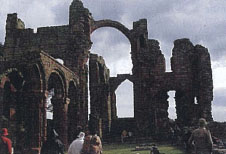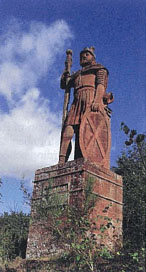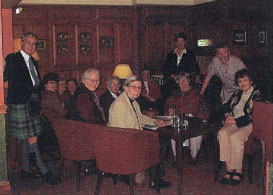
TOURING THE BORDER COUNTRY
SOME OF US BEGAN our British Heritage/Lord Addison tour of Sir Walter Scott’s Border Country a bit early by taking day flights from Boston and Washington Dulles on Thursday, 18th September, just ahead of Hurricane Isabel’s attack on the East Coast. Safely in London that evening, I met old friends Alice, Nancy, Win, and new-to-me friend Neva in the bar of the Heathrow Hilton’s soaring atrium before heading off to bed for a good night’s sleep. Lord Addison’s driver met us at the Edinburgh airport after our Friday morning flight to Scotland’s capital, along with Ann, Ruth Ann, Betty and another Judy (we both found ourselves referred to as “the other Judy” thropghout the trip), for a ride to our hotel in Edinburgh’s New Town, The Roxburghe on Charlotte Square, just a block or so from Princes Street and not far from where Scott was born in 1771.
A group of us went to a Monet exhibition at the newly restored Royal Scottish Academy and strolled through lovely Prince’s Street Gardens before meeting at the hotel for dinner with the others, plus Joan, who’d arrived a couple of days early for shopping, Patty, whose flight had been delayed because of the hurricane, and our courier Ian McDonald, looking splendid in his kilt.
Our sightseeing began in earnest on Saturday when veteran Lord Addison driver Steve Rogers, also kilted and always a favourite, called for us in his minicoach for a drive around history-packed Edinburgh, Old Town, New Town, and Leith, narrated in great detail by Ian. On foot we explored Edinburgh Castle on its dramatic bluff and St. Giles Cathedral, where John Knox stirred up church reform. The rest of the day we wandered in different directions, revisiting some of the sites we’d seen that morning, doing a bit of shopping, or relaxing before heading out on the town for dinner.
[caption id="LettersfromourReaders_img1" align="aligncenter" width="226"]

[caption id="LettersfromourReaders_img2" align="aligncenter" width="146"]

[caption id="LettersfromourReaders_img3" align="aligncenter" width="273"]

WE LEFT EDINBURGH BEHIND on Sunday to explore grand Floors Castle and its gardens, followed by an afternoon at Mellerstain House with its Robert Adams designs. A visit to Smailholm Tower, forbidding atop its rocky perch, called to mind Sir Walter Scott, who’d visited here. An exhibition in the Tower illustrated some of his stories. At the end of the day we pulled up to Dryburgh Abbey Hotel, just yards from the Abbey’s ruins, for a fine dinner and well-earned sleep.
The ruins of another abbey, Melrose, awaited us the next morning. Here, it’s said, is buried the heart of Robert the Bruce. Scott’s home, Abbotsford, was next. He died here, lying in a bed brought into the dining room for him. I We also stopped in Selkirk to see the courtroom where Scott was sheriff (judge), and to have lunch before riding through the scenic Lammermuirs to venerable Traquair House. This oldest continuously inhabited dwelling in Scotland has hosted 27 Scottish kings, Mary Queen of Scots, and Bonnie Prince Charlie. It began as a tower house like Smailholm that was used as a hunting lodge, then was expanded into a sizable house. Traquair Ale is made here in a brewery strangely situated under the chapel. Our day’s travels ended with a look at Scott’s View, where the author always stopped on his way home. Ian told us that Scott’s funeral procession passed this way, and Scott’s bier was pulled by his horse. When the animal reached this spot, it stopped on its own, one last time.
Tuesday morning we walked across the hotel lawn to have a look at the ruins of Dryburgh Abbey where Scott lies buried, then returned to the hotel for tea before setting off for the Wallace Statue, with a view almost the same as Scott’s View and wild blackberries at its feet that time of year. A short drive brought us to Kelso, with plenty of time for lunch and shopping. Then we headed to Berwick-upon-Tweed on the east coast and our next hotel. Before dinner, Ian led those of us who felt like some more walking on a ramble along the well-preserved town walls overlooking the mouth of the River Tweed, our watery companion through much of our tour to date.
WE BEGAN OUR WEDNESDAY TRAVELS with a visit to Coldstream and the small museum of the Coldstream Guards. We crossed the Tweed into England to see the Flodden, Battle site, where England and Scotland fought in 1513 with great loss of life. We visited the Ford estate, a village typical of the 19th century. A school there has beautiful paintings created by Lady Waterford. Etal Castle a few hundred yards away has a good museum and a tour that tells the story of the battle. We lunched at Heatherslaw Mill, a cookie factory, then set our course for Chillingham to see its wild cattle. These creatures have been enclosed in the same beautiful high meadow for 700 years and are, as a result, genetically identical to each other, and they’ve picked up some strange behaviours and anatomy over the centuries.
Thursday took us across a causeway to the Holy Island of Lindisfarne and another majestic ruin, Lindisfarne Priory. St. Aidan brought Christianity from the Isle of Iona off Scotland’s western coast to this island on the opposite side in the 7th century. Alnwick and its prosperous market town, splendid castle (where some outdoor Harry Potter scenes were filmed), and beautiful gardens filled the rest of our day.
We left the fascinating Borderlands and said goodbye to Ian and Steve on Friday when we boarded a train at Newcastle to travel to London’s King’s Cross Station. Lizzie Meadows met our train and took us to our hotel, the Westbury on Bond Street, where she passed out maps and gave us ideas for spending our afternoon in the city. We gathered again for a final, jolly dinner.
Saturday saw us heading our separate ways, sad to say goodbye to new friends and old and our wonderful Borders adventure.
Judy Sopronyi
Associate Editor
OFTEN OVERLOOKED
KUDOS TO BRITISH HERITAGE and author Barbara Roisman Cooper for the splendid article, “Real to Reel: WWII and British Film” (November 2003, page 38). An important—but often overlooked—element in all these remarkable films is the soundtrack music scores that so effectively highlighted the action on-screen. Virtually every notable composer of the day took part in this significant contribution to the war effort.
Music for Leslie Howard’s Spitfire was the work of Sir William Walton, who also composed the music to The Foreman Went to France. The score for The Way Ahead was created by William Alwyn, and the ever-resourceful Noël Coward was responsible for the music heard in his film, In Which We Serve.
The dean of English composers, Ralph Vaughan Williams, wrote the scores for several films of the wartime era, i.e., Coastal Command, The Peoples’ Land, Flemish Farm, and The Invaders. Sir Arnold Bax contributed the music for Malta G. C. The prolific Richard Addinsell is best remembered for his stand-alone piece in Suicide Squadron (aka Dangerous Moonlight), the oft-recorded Warsaw Concerto.
AI & Elizabeth Covaia
Brentwood, California
THAT FATEFUL DAY…
THE ARTICLE IN the January 2004 issue, on the R101 airship disaster (page 16) really brought back a childhood memory. We lived in Hendon, London, and I was in the back garden with my grandma and aunt, who were doing some weeding, on that fateful day. We watched the airship fly over us; it was so low that we could read “R101” on the side very clearly. I can remember my family’s horror the next day when the newspapers carried pictures of it going down in flames.
On a different subject, I read the editor’s comments about further articles exploring Britain’s Roman past (page 8). Last week my son and I went to St. Al-bans to visit the cathedral, dedicated to the first British martyr who was beheaded by the Romans. From there we went down the hill to the remains of Verulamium, the 3rd largest Roman city in Britain. The wonderful little museum there held many artefacts and huge mosaic floors that had been dug up in the 1930s. I do so hope that you manage to include this city in your next article.
Regan Kenner
Canton, Missouri
WE ENJOY HEARING FROM YOU!
Please share any recommendations, comments, and discoveries you think other BRITISH HERITAGE READERS would like to hear about. The editors would like to answer. all correspondence; unfortunately, rime does not permit this, but whenever possible and appropriate, we will include readers’ letters with occasional editorial comments in this department. We ask that writers include their names and addresses, and we reserve the privilege of editing letters for reasons of space and clarity. Letters should be addressed to’ THE EDITORS, BRIDSH HERITAGE, 6405 Flank Drive, Harrisburg, PA 17112





Comments